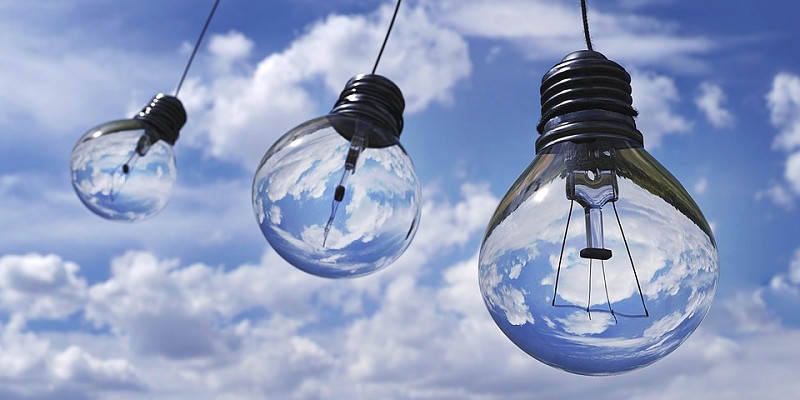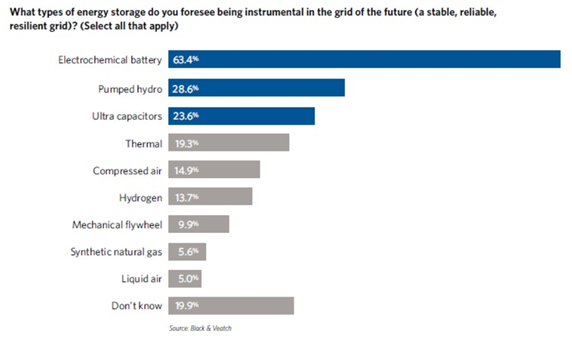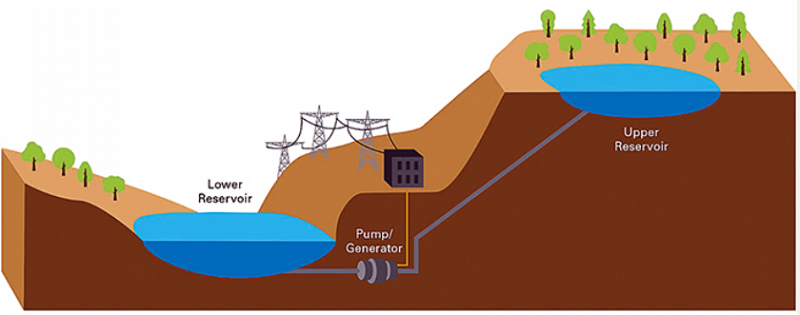The future of storing excess electricity in Northern Ireland

Renewable generating stations are now commonplace in Northern Ireland. Try driving anywhere without coming across a wind turbine or solar panels. Yet, at certain times, the supply is greater than the demand. Therefore, if we are to get the most out of our renewable electricity, an appropriate method for storing the energy generated will need to be discovered. This is the next stage for renewable energy, how do we store the excess electricity?
Several technologies have been developed to store energy. According to a survey by Black and Veatch, the top three types of energy storage people see as being instrumental in the future are; the electrochemical battery, pumped hydro and ultra-capacitors. The results of the survey are shown in Figure 1.
Figure 1 – Graph showing the types of energy storage technologies people see as being instrumental in the future.
Battery energy storage technologies
Batteries have been used for many years, from the standard AAA in your remote control, to the larger battery in your car. All have the same basic concept, when connected to a circuit, a chemical reaction within the battery takes place that allows electrons (electricity) to flow.
The concept is simple, you generate electricity with your renewable generator to power any onsite loads. If the supply becomes greater than the demand, the excess electricity is used to charge the batteries.
However, when we delve deeper into the topic of battery storage, we find a plethora of different battery types: lithium-ion (Li-ion), flow, nickel-based, metal-air, lead-acid, and sodium sulphur batteries are all being considered. The most promising technology at the moment is Li-ion, according to SusChem, this is due to them being the primary consideration for electric vehicles. However, consumers remain wary regarding the lifetime of the batteries, and an appropriate infrastructure will need to be in place before electric vehicles become the norm.
For stationary applications, battery storage is already a popular option and continues to grow.
As shown in Figure 1, batteries are the most popular future energy storage tech, but this is not the only option.
Pumped hydro
Pumped hydro storage is another convenient way to utilise the excess renewable electricity generated. Figure 2 shows the basic operation of a pumped storage system.
Figure 2 – Diagram showing how a pumped hydro station operates
How it works is reasonably simple. Pumped hydro works in much the same way as a regular hydro generator, in that, as water falls from a higher location to a lower location, the movement of the water spins a turbine, which in turn generates electricity. What makes pumped hydro stations different is that the water is pumped back to the upper reservoir during periods when production of electricity is greater than demand.
This type of technology will generally be used by distribution networks, like NIE, as it is unlikely that most of us have two reservoirs in our back gardens. However, this technology may not be suitable for Northern Ireland. A policy briefing written by Prof. N. Hewitt and Prof. P. Griffiths in 2014-15 stated that, “Sites for pump storage in Northern Ireland are limited by the geography, primarily a lack of ‘z’ or vertical drop required to maximise the potential energy of the falling water that can be converted into electricity.”
However, they do go on to say that compressed air is worthy of consideration. This involves compressing the air using renewable electricity and feeding it through turbines when there is demand. They do state that this requires large containers, capable of withstanding considerable pressure, and that the salt bearing beds of East Antrim provide an excellent geological safe base for such caverns.
Ultra-capacitors
Ultra-capacitors are another type of storage technology where energy is stored in an electric field, rather than in a chemical reaction, like batteries. They are highly efficient due to the internal resistance being very small and can survive more than a million charge and discharge cycles.
This technology has been developing rapidly in recent years and with the continued research it will be a promising energy storage technology of the future.
Compressed air
As mentioned above, compressed air is another possible way that energy can be stored for future use. It may not be favoured as much as the storage methods of ultracapacitors and thermal, but it may be a good option for Northern Ireland.
Essentially, any excess energy generated is used to compress air, which in turn generates heat, and if the heat generated during compression can be stored, this provides another option for storing energy. As the compressed air expands, it spins turbines which generate power.
There are three different methods available when considering compressed air energy storage; adiabatic, diabatic and isothermal. All three methods require very large storage containers, and the preferable locations are in artificially constructed underground salt caverns.
What’s next?
For NI to fully utilise its renewable electricity generated, energy storage is going to be of vital importance in the future, and if we intend to use cleaner vehicles, an appropriate infrastructure will need to be put in place.
Overall, research and development will be key in the development of energy storage systems. The choice of energy storage will depend upon several factors, such as geographical location, resources available and the energy storage density needed. Careful consideration will be needed to decide on the energy storage system that will work best for particular circumstances, and it is likely that a combination of technologies will be the best approach.
Find out more about energy storage in our blog with Eddie McGoldrick, Director of PowerOn Technologies.




